How to create a financial forecast for a Hungarian restaurant?
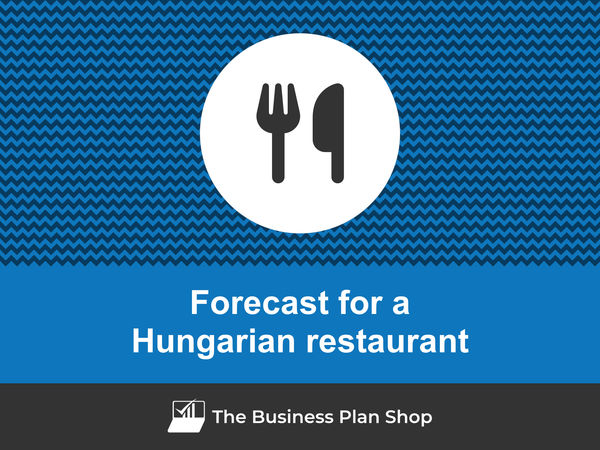
Creating a financial forecast for your Hungarian restaurant, and ensuring it stays up to date, is the only way to maintain visibility on future cash flows.
This might sound complex, but with the right guidance and tools, creating an accurate financial forecast for your Hungarian restaurant is not that hard.
In this guide, we'll cover everything from the main goal of a financial projection, the data you need as input, to the tables that compose it, and the tools that can help you build a forecast efficiently.
Without further ado, let us begin!
Why create and maintain a financial forecast for a Hungarian restaurant?
The financial projections for your Hungarian restaurant act as a financial blueprint to guide its growth with confidence and ensure its long-term financial viability.
To create them, you will need to look at your business in detail - from sales to operating costs and investments - to assess how much profit it can generate in the years to come and what will be the associated cash flows.
During challenging market conditions, maintaining an up-to-date financial forecast enables early detection of potential financial shortfalls, allowing for timely adjustments or securing financing before facing a cash crisis.
Your Hungarian restaurant's financial forecast will also prove invaluable when seeking financing. Banks and investors will undoubtedly request a thorough examination of your financial figures, making precision and presentation essential.
Need a solid financial forecast?
The Business Plan Shop does the maths for you. Simply enter your revenues, costs and investments. Click save and our online tool builds a three-way forecast for you instantly.

What information is used as input to build a Hungarian restaurant financial forecast?
A Hungarian restaurant's financial forecast needs to be built on the right foundation: your assumptions.
The data required to create your assumptions will depend on whether you are a new or existing Hungarian restaurant.
If you are creating (or updating) the forecast of an existing Hungarian restaurant, then your main inputs will be historical accounting data and operating metrics, and your team’s view on what to expect for the next three to five years.
If you are building financial projections for a new Hungarian restaurant startup, you will need to rely on market research to form your go-to-market strategy and derive your sales forecast.
For a new venture, you will also need an itemised list of resources needed for the Hungarian restaurant to operate, along with a list of equipment required to launch the venture (more on that below).
Now that you understand what is needed, let’s have a look at what elements will make up your Hungarian restaurant's financial forecast.
The sales forecast for a Hungarian restaurant
From experience, it usually makes sense to start your Hungarian restaurant's financial projection with the revenues forecast.
The inputs used to forecast your sales will include the historical trading data of your Hungarian restaurant (which can be used as a starting point for existing businesses) and the data collected in your market research (which both new ventures and existing businesses need to project their sales forward).
Your Hungarian restaurant's sales forecast can be broken down into two key estimates:
- The average price
- The number of monthly transactions
To assess these variables accurately, you will need to consider the following factors:
- Seasonal Variations: The demand for Hungarian food may vary throughout the year, with colder months potentially seeing an increase in customers due to traditional winter dishes.
- Popularity of Hungarian Culture: The popularity of Hungarian culture and cuisine in your local area may affect the number of customers and their willingness to pay higher prices for authentic Hungarian dishes.
- Competition: The presence of other Hungarian restaurants in the area may affect your average price and number of transactions, as customers may compare prices and offerings before choosing where to dine.
- Inflation: Changes in the overall cost of living and inflation rates may impact your average price, as you may need to adjust prices to maintain profitability.
- Tourism: If your restaurant is located in a popular tourist destination, the influx of tourists may lead to higher demand and an increase in average price as they are willing to pay for a unique dining experience.
Once you have a sales forecast in place, the next step will be to work on your overhead budget. Let’s have a look at that now.
Need inspiration for your business plan?
The Business Plan Shop has dozens of business plan templates that you can use to get a clear idea of what a complete business plan looks like.

The operating expenses for a Hungarian restaurant
The next step is to estimate the expenses needed to run your Hungarian restaurant on a day-to-day basis.
These will vary based on the level of sales expected, and the location and size of your business.
But your Hungarian restaurant's operating expenses should include the following items at a minimum:
- Staff Costs: This includes wages, salaries, and benefits for your kitchen staff, waitstaff, and management team. You want to make sure you have enough staff to handle the busy periods, but not so many that you are paying unnecessary wages.
- Food and Beverage Costs: This includes the cost of ingredients and supplies for your dishes and drinks. You want to keep these costs in check by carefully managing your inventory and purchasing from reliable suppliers.
- Rent or Lease: Rent or lease for your restaurant space is a significant expense. You want to make sure you are in a location that attracts customers and that the rent is reasonable for your budget.
- Utilities: This includes electricity, gas, water, and other utilities needed to run your restaurant. You can save on these costs by implementing energy-saving measures and negotiating with utility providers.
- Marketing and Advertising: You need to promote your restaurant to attract customers. This can include online marketing, print advertisements, and other promotional materials.
- Accountancy Fees: You may want to hire an accountant to help you manage your finances and taxes. This can be an ongoing expense or a one-time fee for tax preparation.
- Insurance Costs: You need to have insurance to cover your restaurant in case of accidents, property damage, or legal issues. This can include general liability insurance, workers' compensation insurance, and others.
- Software Licences: Restaurant management software, point-of-sale systems, and other software licenses can help you run your restaurant more efficiently. Make sure to budget for these expenses.
- Banking Fees: You may have to pay fees for your business bank account, credit card processing, and other banking services. Shop around to find the best rates for your needs.
- Cleaning and Maintenance: You want to keep your restaurant clean and well-maintained to ensure a positive customer experience. This can include cleaning supplies, equipment repairs, and regular maintenance services.
- Licences and Permits: You need to obtain various licences and permits to legally operate your restaurant, such as a food service permit, liquor license, and health department permits.
- Training and Development: Investing in your staff's training and development can lead to improved service and quality in your restaurant. This can include workshops, seminars, and other training programs.
- Entertainment Expenses: If your restaurant offers live music or other forms of entertainment, you need to budget for these expenses, such as performer fees and equipment rental.
- Taxes: You need to set aside funds for local, state, and federal taxes. Consider hiring a tax professional to help you stay compliant and minimize your tax burden.
- Waste Disposal: Properly disposing of waste and recycling can be costly. Make sure you budget for these expenses, such as garbage collection fees and composting services.
This list is, of course, not exhaustive, and you'll have to adapt it according to your precise business model and size. A small Hungarian restaurant might not have the same level of expenditure as a larger one, for example.
What investments are needed to start or grow a Hungarian restaurant?
Once you have an idea of how much sales you could achieve and what it will cost to run your Hungarian restaurant, it is time to look into the equipment required to launch or expand the activity.
For a Hungarian restaurant, capital expenditures and initial working capital items could include:
- Kitchen Equipment: This includes items such as ovens, stoves, refrigerators, and other necessary equipment for food preparation and storage.
- Furniture and Fixtures: This includes tables, chairs, and other furniture necessary for seating customers, as well as fixtures such as lighting and decor.
- Point-of-Sale System: This includes the software and hardware necessary for processing payments and managing orders.
- Renovations and Repairs: This includes any necessary renovations or repairs to the restaurant space, such as plumbing or electrical work, as well as any updates to the decor or layout.
- Delivery Vehicles: If your restaurant offers delivery services, you may need to purchase vehicles for transporting food to customers.
Again, this list will need to be adjusted according to the specificities of your Hungarian restaurant.
Need a convincing business plan?
The Business Plan Shop makes it easy to create a financial forecast to assess the potential profitability of your projects, and write a business plan that’ll wow investors.

The financing plan of your Hungarian restaurant
The next step in the creation of your financial forecast for your Hungarian restaurant is to think about how you might finance your business.
You will have to assess how much capital will come from shareholders (equity) and how much can be secured through banks.
Bank loans will have to be modelled so that you can separate the interest expenses from the repayments of principal, and include all this data in your forecast.
Issuing share capital and obtaining a bank loan are two of the most common ways that entrepreneurs finance their businesses.
What tables compose the financial plan for a Hungarian restaurant?
Now let's have a look at the main output tables of your Hungarian restaurant's financial forecast.
The profit & loss forecast
The forecasted profit & loss statement will enable you to visualise your Hungarian restaurant's expected growth and profitability over the next three to five years.
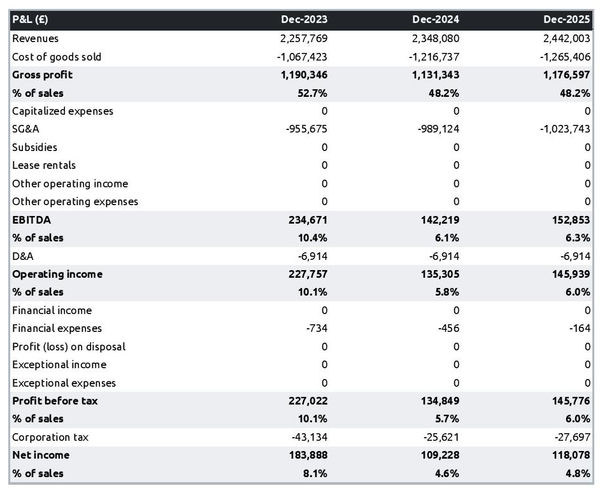
A financially viable P&L statement for a Hungarian restaurant should normally show:
- Sales growing above inflation
- Stable or expanding (ideally) profit margins
- A net profit
This will of course depend on the stage of your business: a new venture might be loss-making until it reaches its breakeven point in year 2 or 3, for example.
The projected balance sheet
The projected balance sheet gives an overview of your Hungarian restaurant's financial structure at the end of the financial year.
It is composed of three categories of items: assets, liabilities and equity:
- Assets: are what the business possesses and uses to produce cash flows. It includes resources such as cash, buildings, equipment, and accounts receivable (money owed by clients).
- Liabilities: are the debts of your Hungarian restaurant. They include accounts payable (money owed to suppliers), taxes due and bank loans.
- Equity: is the combination of what has been invested by the business owners and the cumulative profits to date (which are called retained earnings). Equity is a proxy for the value of the owner's stake in the business.
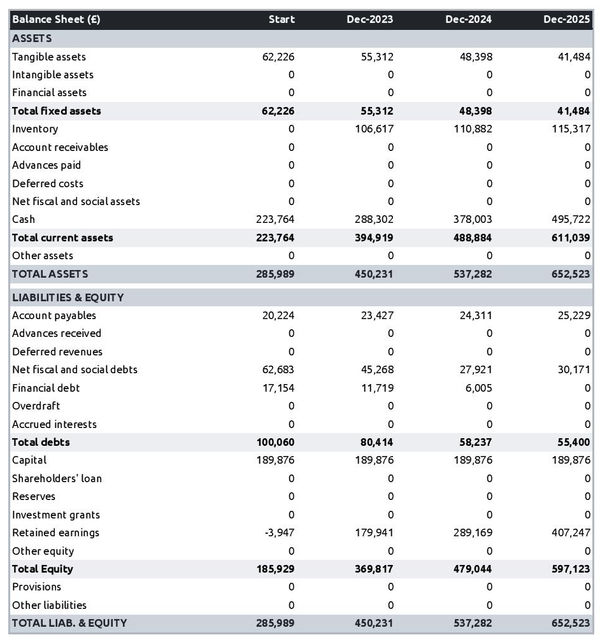
The cash flow projection
The cash flow forecast of your Hungarian restaurant will show how much cash the business is expected to generate or consume over the next three to five years.
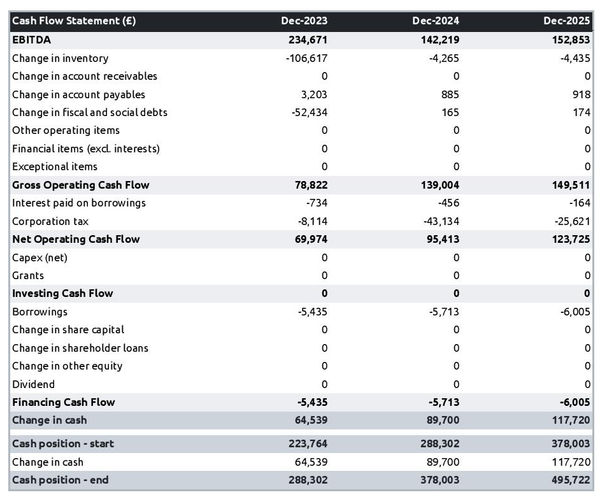
There are multiple ways of presenting a cash flow forecast but from experience, it is better to organise it by nature in order to clearly show these elements:
- Operating cash flow: how much cash is generated by the Hungarian restaurant's operations
- Investing cash flow: what is the business investing to expand or maintain its equipment
- Financing cash flow: is the business raising additional funds or repaying financiers (debt repayment, dividends)
Your cash flow forecast is the most important element of your overall financial projection and that’s where you should focus your attention to ensure that your Hungarian restaurant is adequately funded.
Note: if you are preparing a financial forecast in order to try to secure funding, you will need to include both a yearly and monthly cash flow forecast in your Hungarian restaurant's financial plan.
Need a solid financial forecast?
The Business Plan Shop does the maths for you. Simply enter your revenues, costs and investments. Click save and our online tool builds a three-way forecast for you instantly.

Which tool should you use to create your Hungarian restaurant's financial forecast?
Using the right tool or solution will make the creation of your Hungarian restaurant's financial forecast much easier than it sounds. Let’s explore the main options.
Using online financial forecasting software to build your Hungarian restaurant's projections
The modern and easiest way is to use an online financial forecasting tool such as the one we offer at The Business Plan Shop.
There are several advantages to using specialised software:
- You can easily create your financial forecast by letting the software take care of the financial calculations for you without errors
- You have access to complete financial forecast templates
- You get a complete financial forecast ready to be sent to your bank or investors
- You can easily track your actual financial performance against your financial forecast, and recalibrate your forecast as the year goes by
- You can create scenarios to stress test your forecast's main assumptions
- You can easily update your forecast as time goes by to maintain visibility on future cash flows
- You have a friendly support team on standby to assist you when you are stuck
- It’s cost-efficient and much cheaper than using an accountant or consultant (see below)
If you are interested in this type of solution, you can try our projection software for free by signing up here.
Calling in a financial consultant or chartered accountant
Enlisting the help of a consultant or accountant is also a good way to obtain a professional Hungarian restaurant financial forecast.
The downside of this solution is its cost. From experience, obtaining a simple financial forecast over three years (including a balance sheet, income statement, and cash flow statement) is likely to cost a minimum of £700 or $1,000.
The indicative cost above, is for a small business, and a forecast is done as a one-shot exercise. Using a consultant or accountant to track your actuals vs. forecast and to keep your financial projections up to date on a monthly or quarterly basis will cost a lot more.
If you opt for this solution, make sure your accountant has in-depth knowledge of your industry, so that they may challenge your figures and offer insights (as opposed to just taking your assumptions at face value to create the forecast).
Why not use a spreadsheet such as Excel or Google Sheets to build your Hungarian restaurant's financial forecast?
Creating an accurate and error-free Hungarian restaurant financial forecast on Excel (or any spreadsheet) is very technical and requires both a strong grasp of accounting principles and solid skills in financial modelling.
Most entrepreneurs lack the expertise required to create an accurate financial forecast using spreadsheet software like Excel or Google Sheets. As a result, it is unlikely anyone will trust your numbers.
The second reason is that it is inefficient. Building forecasts on spreadsheets was the only option in the 1990s and early 2000s, nowadays technology has advanced and software can do it much faster and much more accurately.
This is why professional forecasters all use software. With the rise of AI, software is also becoming smarter at helping us detect mistakes in our forecasts and helping us analyse the numbers to make better decisions.
Finally, like everything with spreadsheets, tracking actuals vs. forecasts and updating your forecast as the year progresses is manual, tedious, error-prone, and time-consuming. Whereas financial forecasting software like The Business Plan Shop is built for this.
Need a convincing business plan?
The Business Plan Shop makes it easy to create a financial forecast to assess the potential profitability of your projects, and write a business plan that’ll wow investors.

Use our financial projection templates for inspiration
The Business Plan Shop has dozens of financial forecasting templates available.
Our examples contain both the financial forecast, and a written business plan which presents, in detail, the company, the team, the strategy, and the medium-term objectives.
Whether you are just starting out or already have your own Hungarian restaurant, looking at our template is always a good way to get ideas on how to model financial items and what to write when creating a business plan to secure funding.
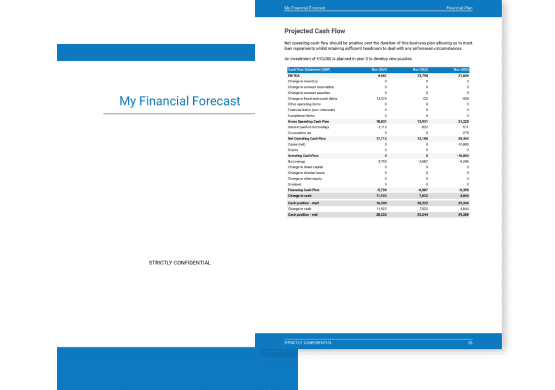
Takeaways
- Having a financial forecast enables you to visualise the expected growth, profitability, and cash generation for your business over the next three to five years.
- Tracking actuals vs. forecast and keeping your financial projections up-to-date is the only way to get a view on what your Hungarian restaurant future cash flows may look like.
- Using financial forecasting software is the mordern and easy way to create and maintain your forecasts.
This is the end of our guide on how to build the financial forecast for a Hungarian restaurant, we hope you found it useful. Don't hesitate to contact us if you want to share your feedback or have any questions.
Need inspiration for your business plan?
The Business Plan Shop has dozens of business plan templates that you can use to get a clear idea of what a complete business plan looks like.

Also on The Business Plan Shop
Know someone who owns or is thinking of starting a Hungarian restaurant? Share our forecasting guide with them!




